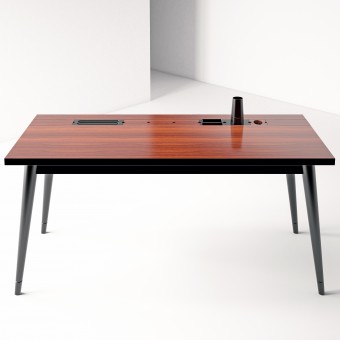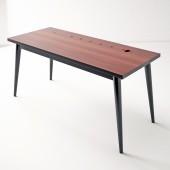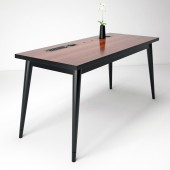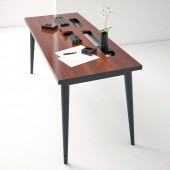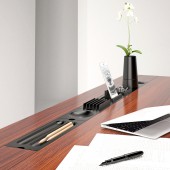DESIGN NAME:
Oz
PRIMARY FUNCTION:
Office Table
INSPIRATION:
We don't always need the same things on the tables. Sometimes we need a vase, a pen holder, a phone holder, and when we don't need these parts, it is a problem where we can lift them off the table. Also, the pieces that everyone wants to keep on the table top may not be the same. With this table, we can have a flat classic table surface or pieces that will serve 7 different functions. We can choose between one piece and 7 pieces, and place them as we want in respect to the need.
UNIQUE PROPERTIES / PROJECT DESCRIPTION:
It is a table designed for offices. The table contains functional parts that can be changed according to need. There are 7 pieces in the hole spaces left on the table top. These pieces can be rotated in a vertical direction or made invisible. Also, the order of the pieces can be changed among themselves. This variety provides the user not only many different possibilities in the usage, but it also provides an important advantage in terms of personalization.
OPERATION / FLOW / INTERACTION:
7 different functions can be placed in the space designed on the table. The user puts and organize the pieces he wants vertically according to his needs and places them on the table. Since all parts are the same width, they can be used in the desired order. Thanks to this feature, 5040 different sequences can be obtained. Considering the non-rotating variation of some parts, 645.120 different usage patterns are obtained. A great ability has been provided in terms of personalization.
PROJECT DURATION AND LOCATION:
The idea of designing the project Oz created in December 2019 in Ankara, Turkey.
FITS BEST INTO CATEGORY:
Furniture Design
|
PRODUCTION / REALIZATION TECHNOLOGY:
This table can be easily produced with wood material. Coating or paint can be used. While making this choice, the designer keeps the chance to stick to corporate identity. The table consists of a combination of different pieces. Two metal supports are hidden on the underside of the space left in the table top, the moving pieces are placed on the table by these supports. Two sides of the moving pieces are within different coating materials. Thus, the desired function and effect can be achieved.
SPECIFICATIONS / TECHNICAL PROPERTIES:
The table measures 165 cm x 70 cm. The pen holder is the longest piece and is 30 cm, the cable channel is 10 cm, the other 5 pieces are 15 cm long. The width of the 7 pieces is 10 cm. The height of the table is 75 cm and the thickness of the table top is 3 mm. The legs of the table are considered as solid wood, table and other parts as coating on chipboard or MDF material.
TAGS:
table, office, personalization, storage, need and functionality
RESEARCH ABSTRACT:
In the context of sustainability, personalization in product design is recommended as it delays replacing the product by strengthening the user-product linkage, extending product life and contributing to the efficient use of resources and creating a more meaningful material culture. In this context, set free the users in the process of use and enabling users to create personal narratives through designing, making and transforming products can support the creation of a stronger product-user link.
CHALLENGE:
While designing a table that can be shaped depending on the need, not to get away from the general design line is the starting point of this design.
ADDED DATE:
2020-02-22 08:30:20
TEAM MEMBERS (1) :
Bulent Unal
IMAGE CREDITS:
Image #1: 3D Visualization Bulent Unal, 2019.
Image #2: 3D Visualization Bulent Unal, 2019.
Image #3: 3D Visualization Bulent Unal, 2019.
Image #4: 3D Visualization Bulent Unal, 2019.
Image #5: 3D Visualization Bulent Unal, 2019.
|




